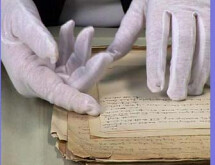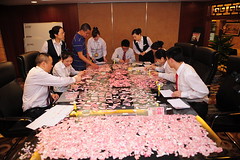 I was reading through the latest Es-Sylum and wanted to say that I enjoy the ongoing discussion and article links about wearing cotton gloves to handle rare books and manuscripts. We also get this question a lot here at the ANS Library and I have always preferred the practice of not wearing gloves but handling with clean hands for the very reasons outlined in the articles that were linked to in The E-Sylum (especially the brief overview by the preservation coordinator at the British Library). Now I have additional resources to point to when this question arises here again!
I was reading through the latest Es-Sylum and wanted to say that I enjoy the ongoing discussion and article links about wearing cotton gloves to handle rare books and manuscripts. We also get this question a lot here at the ANS Library and I have always preferred the practice of not wearing gloves but handling with clean hands for the very reasons outlined in the articles that were linked to in The E-Sylum (especially the brief overview by the preservation coordinator at the British Library). Now I have additional resources to point to when this question arises here again!
To read the earlier E-Sylum article, see:
MORE ON WEARING COTTON GLOVES
(www.coinbooks.org/esylum_v15n19a14.html)
I've heard thanks from other readers as well, include Craig Whitford, who passed the article on to a local historical society curator. Thanks to everyone for bringing up the subject and following through with some great information.
-Editor
A Folded Banknote Shirt
Howard Berlin writes:
 The April 29th E-Sylum issue mentioned the article of "Everyday Art: The Banknote" as an example of banknote folding "art." Several years ago I visited the Newman Money Museum on the campus of Washington University in St. Louis, where I did my graduate work in electrical and biomedical engineering years ago.
The April 29th E-Sylum issue mentioned the article of "Everyday Art: The Banknote" as an example of banknote folding "art." Several years ago I visited the Newman Money Museum on the campus of Washington University in St. Louis, where I did my graduate work in electrical and biomedical engineering years ago.
Among his many items on display was a clever use of multiple $1 bills folded to create a shirt to illustrate the theme, Don't Lose Your Shirt to Inflation." There was also a companion shirt of $2 bills with yellow buttons.
To read the earlier E-Sylum article, see:
EVERYDAY ART: THE BANKNOTE
(www.coinbooks.org/esylum_v15n18a28.html)
Labor rates in China
Ron Abler writes:
 Labor rates must be even lower in China than I thought! The article claims that bank employees spent 72 man-hours reassembling a single 100 Yuan note (equivalent to less than $16!). That's 22 cents an hour!
Labor rates must be even lower in China than I thought! The article claims that bank employees spent 72 man-hours reassembling a single 100 Yuan note (equivalent to less than $16!). That's 22 cents an hour!
To read the earlier E-Sylum article, see:
PSYCHOTIC WOMAN TEARS UP BANKNOTES
(www.coinbooks.org/esylum_v15n19a29.html)
On the Usefulness of Counterfeit-Detecting Marking Pens
Joe Boling writes:
The use of the magic pens to validate currency will lead to many errors. It is not correct that "old" money will fail the test. I have tested notes back into the 1934 series, and they not only pass, but a few weeks after being marked, the marks have faded away. A note the fails has been contaminated with something during its circulating life that reacts to the pen. On the other hand, most teens can devise a way to make the products of their desktop printers pass the pen test.
To read the earlier E-Sylum article, see:
MAN ARRESTED FOR CARRYING A REAL $50 BILL
(www.coinbooks.org/esylum_v15n19a28.html)
Wayne Homren, Editor
The Numismatic Bibliomania Society is a non-profit organization
promoting numismatic literature. See our web site at coinbooks.org.
To submit items for publication in The E-Sylum, write to the Editor
at this address: whomren@gmail.com
To subscribe go to: https://my.binhost.com/lists/listinfo/esylum
Copyright © 1998 - 2024 The Numismatic Bibliomania Society (NBS)
All Rights Reserved.
NBS Home Page
Contact the NBS webmaster